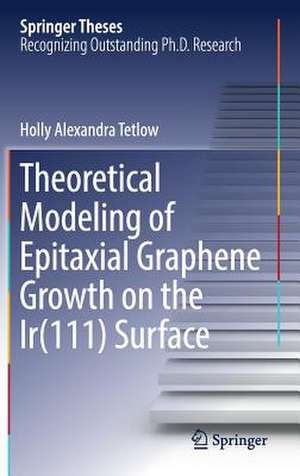Theoretical Modeling of Epitaxial Graphene Growth on the Ir(111) Surface: Springer Theses
Autor Holly Alexandra Tetlowen Limba Engleză Hardback – 11 oct 2017
In closing, the healing of single vacancy defects in the graphene/Ir(111) surface is investigated, and attempts to heal said defects using ethylene molecules is simulated with molecular dynamics and NEB calculated energy barriers.
| Toate formatele și edițiile | Preț | Express |
|---|---|---|
| Paperback (1) | 357.47 lei 39-44 zile | |
| Springer International Publishing – 15 aug 2018 | 357.47 lei 39-44 zile | |
| Hardback (1) | 389.88 lei 6-8 săpt. | |
| Springer International Publishing – 11 oct 2017 | 389.88 lei 6-8 săpt. |
Din seria Springer Theses
- 18%
 Preț: 997.88 lei
Preț: 997.88 lei -
 Preț: 389.88 lei
Preț: 389.88 lei - 15%
 Preț: 646.94 lei
Preț: 646.94 lei - 18%
 Preț: 943.43 lei
Preț: 943.43 lei -
 Preț: 399.29 lei
Preț: 399.29 lei - 18%
 Preț: 944.99 lei
Preț: 944.99 lei - 15%
 Preț: 636.80 lei
Preț: 636.80 lei - 18%
 Preț: 941.05 lei
Preț: 941.05 lei - 15%
 Preț: 643.16 lei
Preț: 643.16 lei - 15%
 Preț: 642.68 lei
Preț: 642.68 lei - 18%
 Preț: 1103.62 lei
Preț: 1103.62 lei - 20%
 Preț: 558.82 lei
Preț: 558.82 lei - 18%
 Preț: 1112.30 lei
Preț: 1112.30 lei - 18%
 Preț: 944.19 lei
Preț: 944.19 lei - 18%
 Preț: 1109.92 lei
Preț: 1109.92 lei - 18%
 Preț: 1217.27 lei
Preț: 1217.27 lei - 15%
 Preț: 640.06 lei
Preț: 640.06 lei - 15%
 Preț: 636.45 lei
Preț: 636.45 lei - 15%
 Preț: 640.06 lei
Preț: 640.06 lei - 15%
 Preț: 640.88 lei
Preț: 640.88 lei -
 Preț: 389.70 lei
Preț: 389.70 lei - 20%
 Preț: 563.89 lei
Preț: 563.89 lei -
 Preț: 393.35 lei
Preț: 393.35 lei - 15%
 Preț: 637.93 lei
Preț: 637.93 lei - 15%
 Preț: 641.85 lei
Preț: 641.85 lei - 18%
 Preț: 1225.94 lei
Preț: 1225.94 lei - 20%
 Preț: 551.36 lei
Preț: 551.36 lei - 18%
 Preț: 1229.10 lei
Preț: 1229.10 lei - 15%
 Preț: 639.25 lei
Preț: 639.25 lei - 18%
 Preț: 999.45 lei
Preț: 999.45 lei - 15%
 Preț: 640.06 lei
Preț: 640.06 lei - 18%
 Preț: 1220.45 lei
Preț: 1220.45 lei - 18%
 Preț: 1116.26 lei
Preț: 1116.26 lei - 18%
 Preț: 1110.72 lei
Preț: 1110.72 lei - 18%
 Preț: 1000.87 lei
Preț: 1000.87 lei - 18%
 Preț: 891.17 lei
Preț: 891.17 lei - 15%
 Preț: 640.06 lei
Preț: 640.06 lei - 5%
 Preț: 1154.07 lei
Preț: 1154.07 lei - 15%
 Preț: 635.96 lei
Preț: 635.96 lei - 15%
 Preț: 640.88 lei
Preț: 640.88 lei -
 Preț: 387.20 lei
Preț: 387.20 lei - 18%
 Preț: 1109.92 lei
Preț: 1109.92 lei -
 Preț: 385.25 lei
Preț: 385.25 lei -
 Preț: 385.25 lei
Preț: 385.25 lei - 18%
 Preț: 1112.30 lei
Preț: 1112.30 lei - 18%
 Preț: 999.45 lei
Preț: 999.45 lei -
 Preț: 386.99 lei
Preț: 386.99 lei - 15%
 Preț: 637.13 lei
Preț: 637.13 lei - 20%
 Preț: 554.20 lei
Preț: 554.20 lei - 20%
 Preț: 555.57 lei
Preț: 555.57 lei
Preț: 389.88 lei
Nou
Puncte Express: 585
Preț estimativ în valută:
74.60€ • 77.74$ • 61.77£
74.60€ • 77.74$ • 61.77£
Carte tipărită la comandă
Livrare economică 03-17 aprilie
Preluare comenzi: 021 569.72.76
Specificații
ISBN-13: 9783319659718
ISBN-10: 3319659715
Pagini: 182
Ilustrații: XV, 182 p. 108 illus., 63 illus. in color.
Dimensiuni: 155 x 235 mm
Greutate: 0.46 kg
Ediția:1st ed. 2017
Editura: Springer International Publishing
Colecția Springer
Seria Springer Theses
Locul publicării:Cham, Switzerland
ISBN-10: 3319659715
Pagini: 182
Ilustrații: XV, 182 p. 108 illus., 63 illus. in color.
Dimensiuni: 155 x 235 mm
Greutate: 0.46 kg
Ediția:1st ed. 2017
Editura: Springer International Publishing
Colecția Springer
Seria Springer Theses
Locul publicării:Cham, Switzerland
Cuprins
Introduction.- Theoretical Methods.- Producing a Source of Carbon: Hydrocarbon Decomposition.- Hydrocarbon Decomposition: Kinetic Monte Carlo Algorithm.- Thermal Decomposition in Graphene Growth: Kinetic Monte Carlo Results.- Beginnings of Growth: Carbon Cluster Nucleation.- Removing Defects: Healing Single Vacancy Defects.- Final Remarks.
Textul de pe ultima copertă
One possible method of producing high-quality graphene is to grow it epitaxially; this thesis investigates the mechanisms involved in doing so. It describes how the initial stages of growth on the Ir(111) surface are modelled using both rate equations and kinetic Monte Carlo, based upon nudged elastic band (NEB) calculated reaction energy barriers. The results show that the decomposition mechanism involves production of C monomers by breaking the C-C bond.
In turn, the thesis explores the nucleation of carbon clusters on the surface from C monomers prior to graphene formation. Small arch-shaped clusters containing four to six C atoms, which may be key in graphene formation, are predicted to be long-lived on the surface.
In closing, the healing of single vacancy defects in the graphene/Ir(111) surface is investigated, and attempts to heal said defects using ethylene molecules is simulated with molecular dynamics and NEB calculated energy barriers.
In closing, the healing of single vacancy defects in the graphene/Ir(111) surface is investigated, and attempts to heal said defects using ethylene molecules is simulated with molecular dynamics and NEB calculated energy barriers.
Caracteristici
Nominated as an outstanding PhD thesis by the King’s College London, London, UK A detailed exploration of a method for growing high quality graphene Includes clear description of all the necessary theoretical tools Includes supplementary material: sn.pub/extras
